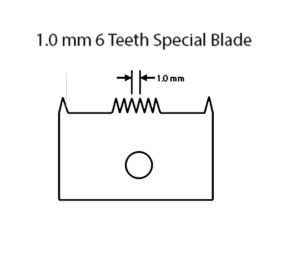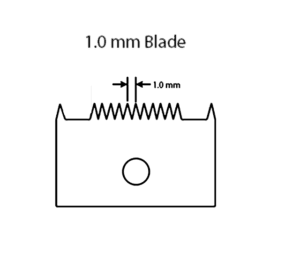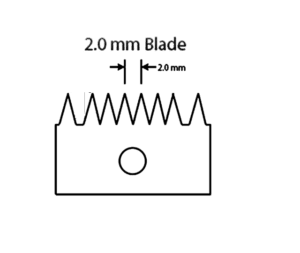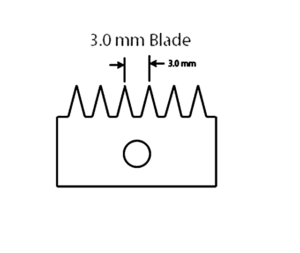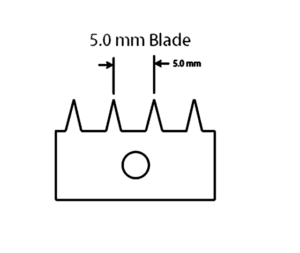Cross cut kit testing gives you a fast and affordable method of visual comparison for paint adhesion as well as any other coating you wish to evaluate for adhesion properties. The cross cut kit paint or test coating is cut into small squares which reduces lateral bonding allowing the coating to be assessed against ASTM D3359 and other industry standards.
The Paint Adhesion Test Kit also known as Cross Cut Kit by Precision Gage & Tool Company provides everything you need to perform adhesion and flexibility tests to meet the standards of the ASTM test method D-3359.
Additionally, replacement accessories for cross cut kits, such as cross cut blades and 51596 test tape, are also available for purchase online . If you have any questions, please call 937-866-9666.
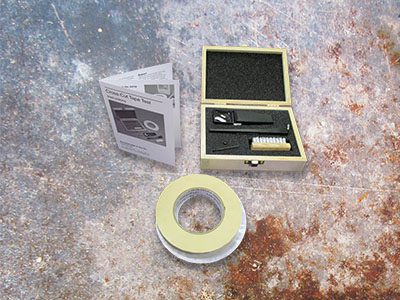
Each Cross Cut Kit includes the following:
- a cutting blade * (most other kits available online do not include the cutting blade)
- blade holder/handle
- cleaning brush
- lighted magnifier
- one roll of test tape
- a hex wrench for changing blades
- an extra clamp screw
* It’s worth noting again that each of our adhesion test kits include a blade and are still priced lower than most of our competitors! Our test kits also comes in a finished wooden case lined with a protective pre-cut foam and easy to follow instructions.
Cross Cut Kit Blades
Our cross cut kit blades come in 6 different blade configurations with a gap between teeth ranging from 1.0 mm up to 5.0 mm.
Click on an image below for a larger view
Cross Cut Kit Test Materials and Procedures
The information below is taken from the included cross cut adhesion test kit instructions and is also available for download here as part of the Cross Cut Kit Manual.
Materials
As mentioned above, our cross cut test kit provides everything you need to perform adhesion and flexibility tests to meet the standards of ASTM Test method D-3359. In the kit, you’ll find a blade, a blade holder/handle, a hex wrench for changing blades, an extra clamp screw, a small flaking and cleaning brush, a lighted magnifier, and a roll of test tape. You’ll also need a rubber eraser on the end of a pencil.
Test Speciment
In the field, you’ll test the actual coated structure or article you want to evaluate. In the lab, you may apply the materials you’re testing to panels of the appropriate composition and surface conditions. Either way, the testing surface must be flat. You can check flatness with a straight edge such as a steel rule.
Cross Cut Kit Testing Procedure
- Make sure your specimen is at room temperature (or other mutually agreed upon temperature) and placed on a firm base.
- Select an area free of blemishes and minor surface imperfections. Under the illumination of the magnifier, use the cross-cut tool to make parallel cuts as follows:
- For dry film coatings of thickness of 2.0 mils (50 μm) or less, use a fine blade (1.0 mm spacing). For coatings having a dry film thickness between 2.0 mils (50 μm) and 5 mils (125 μm), choose a medium (1.5 mm spacing) or coarse (2.0 mm spacing) blade.
- Make the first cut about 3/4 in. (20 mm) long. Cut through the film to the substrate in one steady motion, using just enough pressure to reach the substrate.
- After making the cut, gently remove any detached flakes or ribbons from the film with your kit’s brush.
- Next, make a second cut at 90 degrees to and centered on the original cuts to create a grid pattern in the film.
- Brush the area again and inspect the cuts to make sure you’ve reached the substrate. If not, make another grid in a different location.
- Remove two complete laps of your kit’s test tape and discard. Remove an additional length at a steady rate (don’t jerk it) and cut a piece about 3 in. (75 mm) long.
- Place the center of the tape over the grid and smooth it into place. To make good contact with the film, rub the tape firmly with a pencil eraser. The color under the tape helps you determine when you’ve made good contact.
Report
Report the number of tests, their mean and range, and where the failure occurred—i.e., between the first coat and substrate, between the first and second coat, etc. Note the substrate used, the type of coating and the method of cure. If the adhesion strength of the tape has been determined in accordance with ASTM Test Methods D-3359-17, report the results with the adhesion ratings. Otherwise, report the specific tape used.
Precision and Bias
se the following criteria to judge the acceptability of your results.
Repeatability — If adhesion is uniform over the surface being tested, results obtained for two measurements by the same operator should not differ by more than one rating category.
Reproducibility — Test results obtained by different operators (each the mean of two measurements) should not differ by more than two rating categories.
Bias cannot be established for these test methods.
Click here to download a PDF of our Cross Cut Kit Manual which includes these instructions

